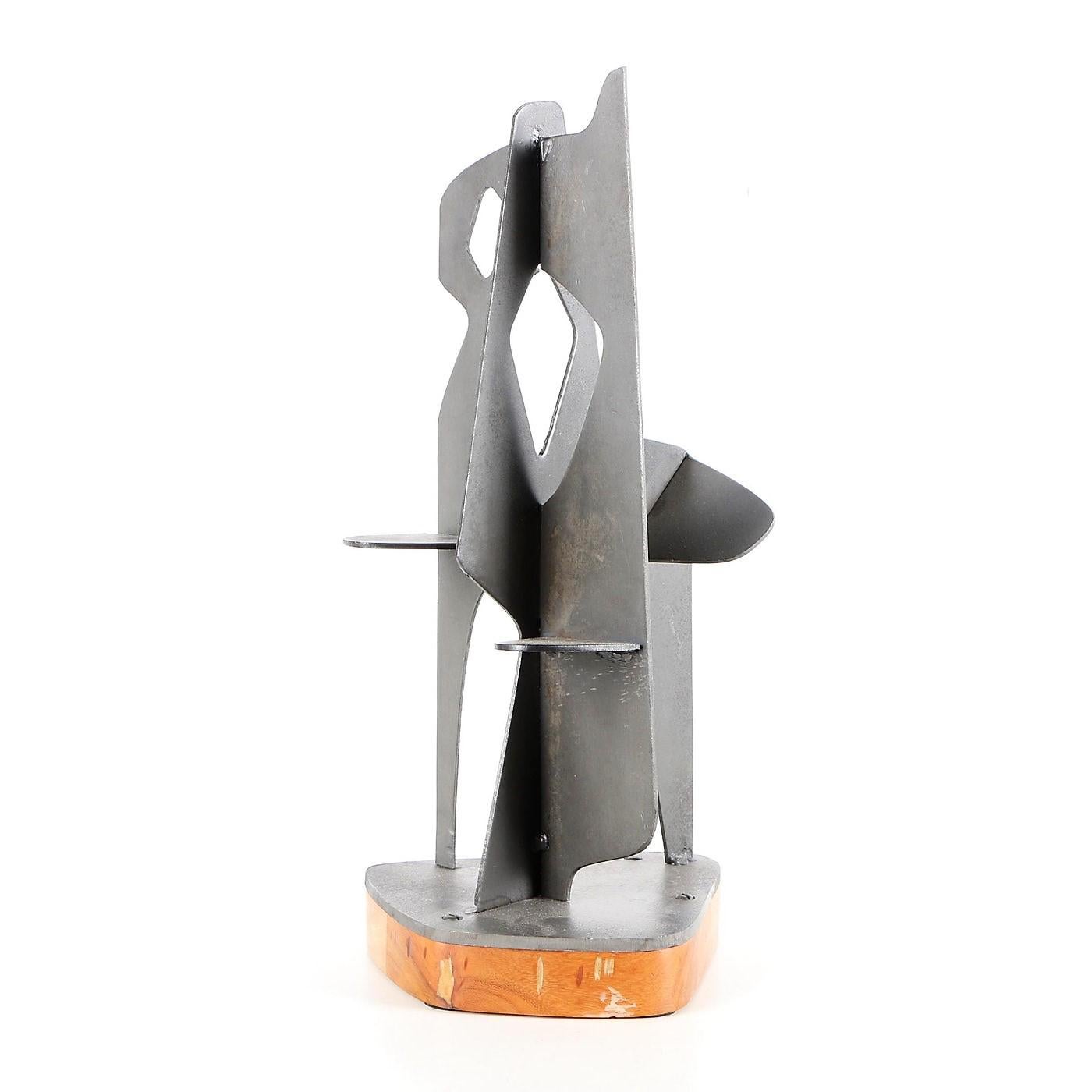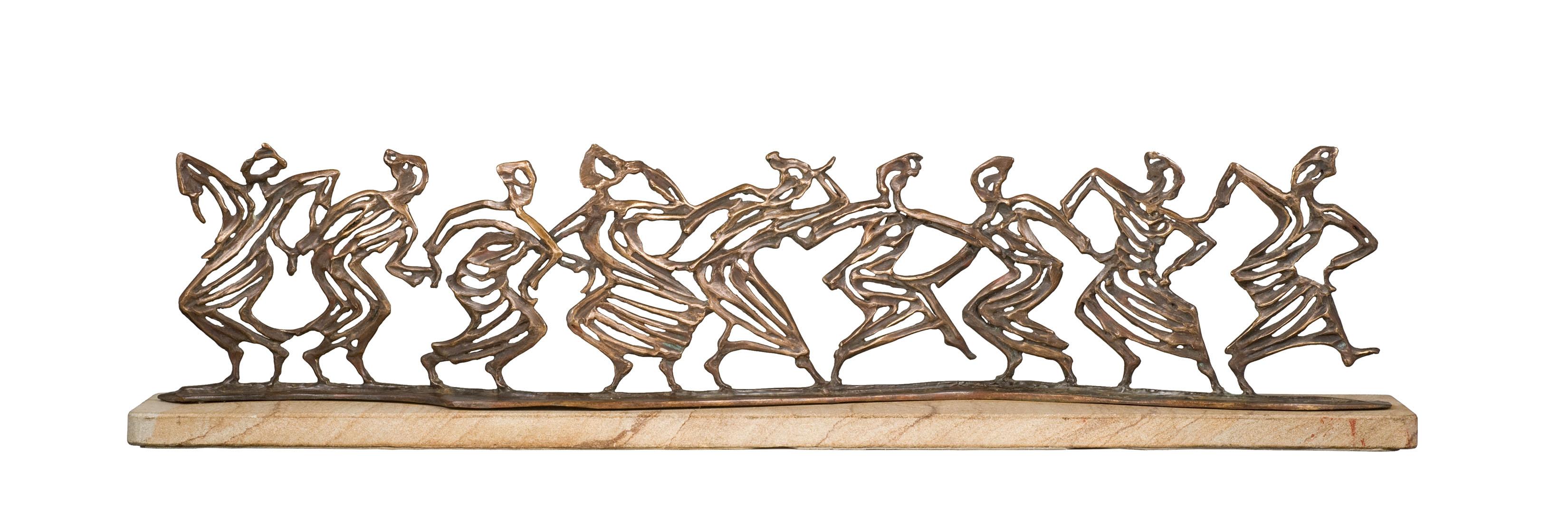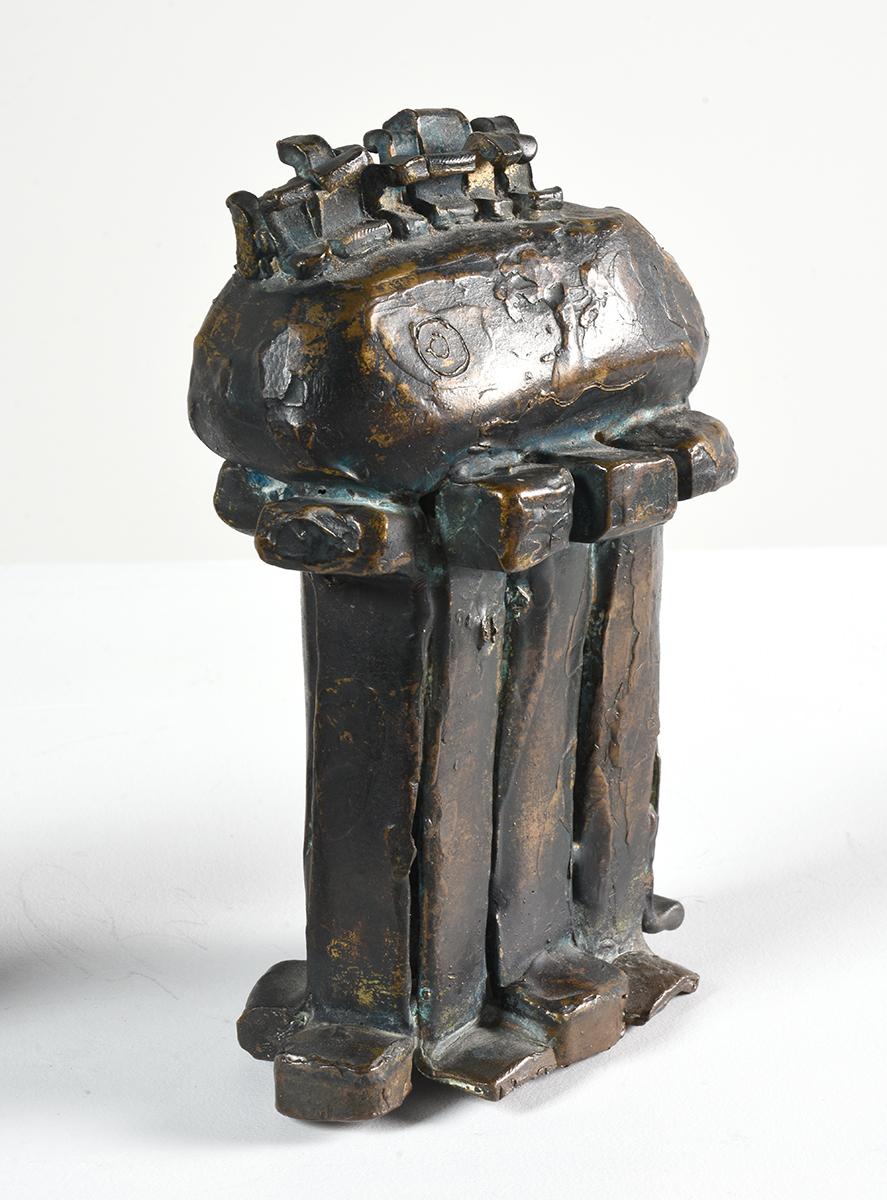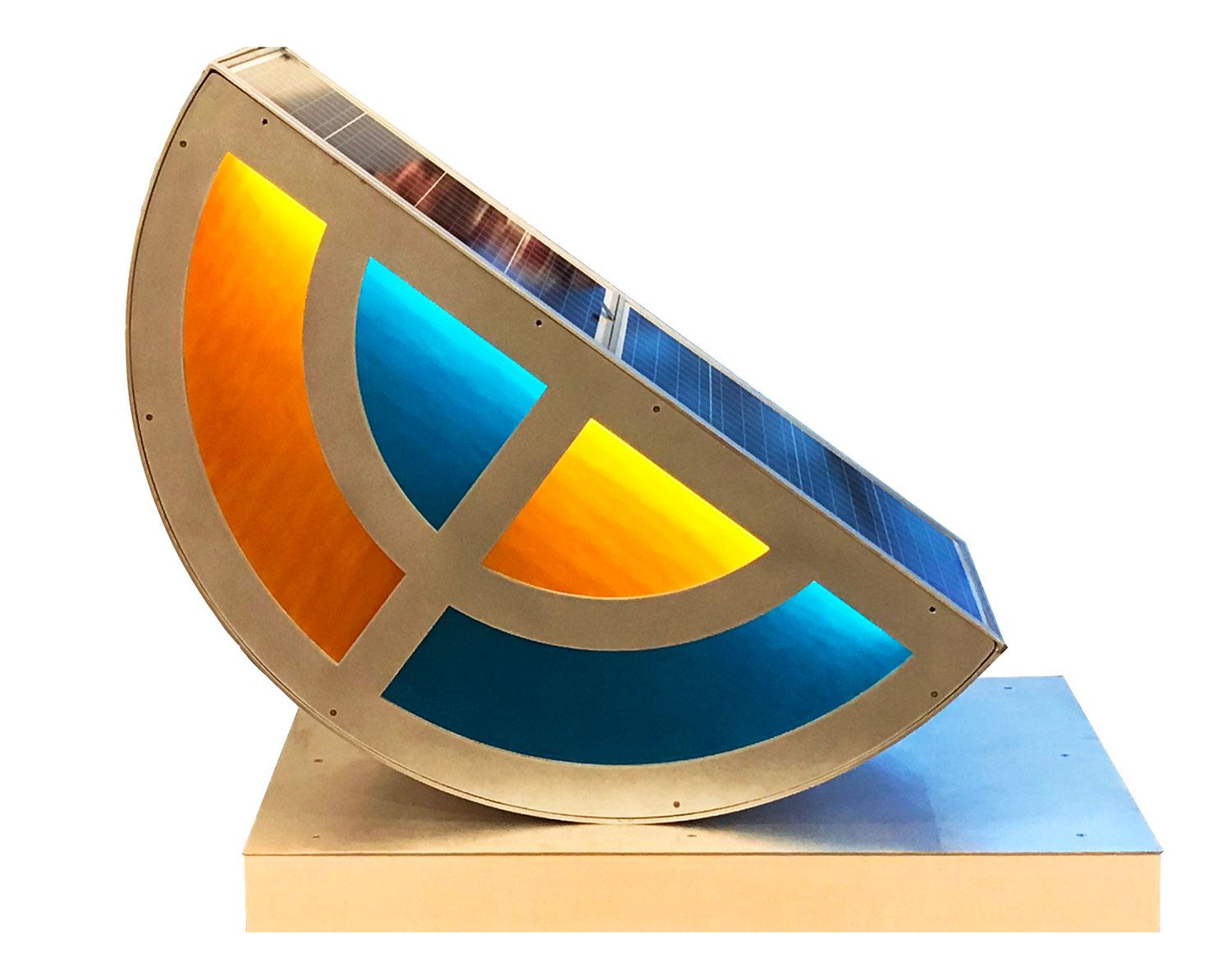Items Similar to Abstract Sculpture Mid 20th Century Modern Non Objective Biomorphic Plaster WPA
Want more images or videos?
Request additional images or videos from the seller
1 of 4
George L.K. MorrisAbstract Sculpture Mid 20th Century Modern Non Objective Biomorphic Plaster WPA1930s/40s
1930s/40s
About the Item
Modern artist George L.K. Morris created this abstract biomorphic non0objective plaster sculpture during the WPA era of the 1930s / 40s.
Though George Lovett Kingsland Morris studied with realist painters John Sloan and Kenneth Hayes Miller at the Art Students League, the influence of their points of view was replaced by that of abstractionists Amedee Ozenfant and Fernand Leger. The paintings of Morris were two-dimensional, hard-edged and brightly colored.
Born in New York City in 1905, Morris became a full-fledged abstractionist and a founder in 1936 of the American Abstract Artists. He edited "The World of Abstract Art, the group's publication, and was their president from 1948-1950.
Morris had graduated from Yale in 1928 and studied at the League until 1930, when he went to Paris to attend the Academie Moderne. A sculptor, writer, art critic and teacher in addition to abstract painter Morris himself later taught at the Art Students League from 1943-1944, as well as St. John's College, Annapolis, Maryland, 1960-1961.
Morris' intrinsic abstract bent was made even clearer by his positive feeling for Hans Arp's sculpture. He and Arp edited the French art magazine, "Plastique." Morris also edited the "Bulletin of the Museum of Modern Art" and "Partisan Review."
He died in 1975 in New York City.
George LK Morris created this mid 20th century plaster abstract sculpture. It is a non objective biomorphic abstraction.
George Lovett Kingsland Morris was widely exhibited. His work is represented in major museums: the Brooklyn Museum; Corcoran Gallery of Art, Phillips Collection and National Museum of American Art, Smithsonian Institution in Washington, D.C.; Metropolitan Museum of Art and Whitney Museum of American Art in New York City; North Carolina Museum of Art, Raleigh; Philadelphia Museum of Art; and Pennsylvania Academy of the Fine Arts, Philadelphia.
The sculpture it self is 11 x 9 x 3. The wood base is 4" tall.
- Creator:George L.K. Morris (1905-1975, American)
- Creation Year:1930s/40s
- Dimensions:Height: 15 in (38.1 cm)Width: 9 in (22.86 cm)Depth: 3 in (7.62 cm)
- Medium:
- Movement & Style:
- Period:
- Condition:
- Gallery Location:New York, NY
- Reference Number:1stDibs: LU115625102422
About the Seller
5.0
Platinum Seller
These expertly vetted sellers are 1stDibs' most experienced sellers and are rated highest by our customers.
Established in 2008
1stDibs seller since 2019
164 sales on 1stDibs
Typical response time: <1 hour
- ShippingRetrieving quote...Ships From: New York, NY
- Return PolicyA return for this item may be initiated within 3 days of delivery.
More From This SellerView All
- "Construction 1982" Abstract Wall Sculpture Contemporary Mid 20th Century ModernBy Seymour FogelLocated in New York, NY"Construction 1982" Abstract Wall Sculpture Contemporary Mid 20th Century Modern Painted wood assemblage, 36 x 45 x 4 inches overall. Note the label states 3 foot diameter referring to circular portion. Exhibited, Seymour Fogel Constructions Paintings and Drawing, 1984, typed on Graham Modern label verso Seymour Fogel was born in New York City on August 24, 1911. He studied at the Art Students League and at the National Academy of Design under George Bridgeman and Leon Kroll. When his formal studies were concluded in the early 1930s he served as an assistant to Diego Rivera who was then at work on his controversial Rockefeller Center mural. It was from Rivera that he learned the art of mural painting. Fogel was awarded several mural commissions during the 1930s by both the Works Progress Administration (WPA) and the Treasury Section of Fine Arts, among them his earliest murals at the Abraham Lincoln High School in Brooklyn, New York in 1936, a mural in the WPA Building at the 1939-1940 New York World's Fair, a highly controversial mural at the U.S. Post Office in Safford, Arizona (due to his focus on Apache culture) in 1941 and two murals in what was then the Social Security Building in Washington, D.C., also in 1941. Fogel's artistic circle at this time included Phillip Guston, Ben Shahn, Franz Kline, Rockwell Kent and Willem de Kooning. In 1946 Fogel accepted a teaching position at the University of Texas at Austin and became one of the founding artists of the Texas Modernist Movement. At this time he began to devote himself solely to abstract, non-representational art and executed what many consider to be the very first abstract mural in the State of Texas at the American National Bank in Austin in 1953. He pioneered the use of Ethyl Silicate as a mural medium. Other murals and public works of art done during this time (the late 1940s and 1950s) include the Baptist Student Center at the University of Texas (1949), the Petroleum Club in Houston (1951) and the First Christian Church, also in Houston (1956), whose innovative use of stained glass panels incorporated into the mural won Fogel a Silver Medal from the Architectural League of New York in 1958. Fogel relocated to the Connecticut-New York area in 1959. He continued the Abstract Expressionism he had begun exploring in Texas, and began experimenting with various texturing media for his paintings, the most enduring of which was sand. In 1966 he was awarded a mural at the U.S. Federal Building in Fort Worth, Texas. The work, entitled "The Challenge of Space", was a milestone in his artistic career and ushered in what has been termed the Transcendental/Atavistic period of his art, a style he pursued up to his death in 1984. Painted and raw wood sculpture...Category
1980s Assemblage Abstract Sculptures
MaterialsWood
- "Square" Contemporary Geometric Abstract Sculpture Bronze Unique European.By Bruno RomedaLocated in New York, NY"Square" Contemporary Geometric Abstract Sculpture Bronze Unique European. The sculpture measure 10 h x 11 wi inches. Geometric "Circle"...Category
1990s Contemporary Abstract Sculptures
MaterialsBronze
- Contemporary Geometric Abstract Sculpture Bronze Unique Italian European 1983By Bruno RomedaLocated in New York, NYContemporary Geometric Abstract Sculpture Bronze Unique Italian European 1983 Triangle, 1983, bronze. 6 x 12.25 x 2 inches. Signed and dated on both the sculpture and the base BIO Bruno Romeda is a complete artist because all his work always begins by a joining of twigs, rods and sticks, keeping tension and balance. Inspired by primitive geometric forms, as circle, square and triangle, Romeda is playing with projected shadows. As handed-tracks lines, his sculptures and his furniture are casted in bronze in his Italian workshop in Brescia. We find out same figures casted in bronze in bases, retaining structures on which seats, chairs, tables or pedestals are resting. Romeda’s furniture gets perfect shapes from a sort of fossilized nature. The technical perfection, the harmony of proportions and bronze work, summarize Bruno Romeda’s work. Romeda was born in 1933 in Italy and died in 2017. He lived in France, New York and Brescia. The work of Romeda has been exhibited in numerous cities; his first personal exhibition took place in Brussels in 1962, followed by solo shows in Paris, New York, Barcelona, San Francisco, Monte Carlo, Baltimore, berlin, Erbusco (Italy), Venice or Tokyo. A significant number of museums own pieces of the artist such as the Metropolitan Museum of New York, the Kasama Nichido Museum of Art in Japan, the Contemporary Art Museum of Nice, or the Robert College...Category
1980s Abstract Abstract Sculptures
MaterialsBronze
- Brutalist Aluminum Brass Contemporary Totem Sculpture Abstract non objectiveLocated in New York, NYBrutalist Aluminum Brass Contemporary Totem Sculpture Abstract non objective The work has a sensational presence and look great to the ey...Category
21st Century and Contemporary Abstract Abstract Sculptures
MaterialsMetal, Brass
- "Circle" Contemporary Geometric Abstract Sculpture Bronze Unique EuropeanBy Bruno RomedaLocated in New York, NY"Circle" Contemporary Geometric Abstract Sculpture Bronze Unique European. Geometric "Circle" sculpture in bronze by the Italian artist B...Category
Early 2000s Abstract Abstract Sculptures
MaterialsBronze
- Industrial Machine Age American Scene WPA Mid 20th Century 1939 SF World's FairLocated in New York, NYIndustrial Machine Age American Scene WPA Mid 20th Century 1939 SF World's Fair HAIG PATIGIAN (American/Armenian, 1876-1950) Aeronautics Pediments Two Plaster Casts, c. 1930s each 13.25 x 14.75 x 6 inches It's possible these moquettes were created for the 1939 World's Fair, the Golden Gate International Exhibition in San Francisco. Provenance: Private Collection of Lois M. Wright, Author of "A Catalogue of the Life Works of Haig Patigian, San Francisco Sculptor, 1876-1950),” 1967 Loan to Oakland Museum of California (Oakland, CA) BIO Haig Patigian is noted for his classical works, which are especially numerous in public venues in San Francisco, California. Patigian was born in Van, Armenia, which at that time was under Turkish rule. Haig was the son of Avedis and Marine Patigian, both teachers in the American Mission School there. He and his older brother showed an aptitude for art early on and were encouraged by their parents. Their father himself had taken up the new hobby of photography. The 1880s were harsh times, however, for many Armenians under an oppressive rule by the Turkish government. Many people were fleeing to the safety of the United States. Suspicious Turkish authorities accused his father of photographing city structures for the Russian government, and in 1888 he fled for his life to America. Haigs father made his way to Fresno, California, and began life anew as a ranch hand. Within two years he sent for his wife, as well as Haig, his three sisters and brother, and in 1891 the Patigians made the journey from Armenia. Haigs father, an industrious man, worked on various farms, and eventually bought his own ranch and vineyard. It was among fertile farmland of Fresno that Haig grew up. Young Haigs education consisted of teachings by his parents and by intermittent attendance in public schools. Although he had dreams of becoming an artist, he did not have the opportunity for formal study of art, and began working long days in the vineyards around Fresno. At age seventeen, Haig made a step towards his dreams and apprenticed himself to learn the trade of sign painting. In his spare time he nurtured his interest in art by painting nature and life scenes with watercolors and oil paints. When his sign-painting mentor left Fresno, Haig opened his own shop and made a name for himself in the town. San Francisco, in the meantime, had been attracting artists since the Gold Rush and had become a thriving art center. Within a few years, Haig had put aside several hundred dollars to move to San Francisco, joining his brother who was already working there as an illustrator. In 1899, when he was twenty-three, Haig had saved enough money to enroll at the Mark Hopkins Art Institute in San Francisco. Like many aspiring artists of his time, Patigian supported himself by working as a staff artist in the art department of a local newspaper, and in the winter of 1900, nearing his 24th birthday, Haig began work for the San Francisco Bulletin, producing cartoons, black and white illustrations, as well as watercolors. In 1902 tragedy struck Haig and his family. His 29-year-old brother died of pneumonia, and then his frail mother died a short time later. Five months more saw his youngest sister, just out of high school, die too. Saddened and depressed, Haig moved out of the studio he had shared with his brother, and into a dilapidated studio in a poor section of town. During this time of sadness, Haig fed a growing interest in sculpture. In 1904 Haig created what he later called his "first finished piece in sculpture". The work, called "The Unquiet Soul", depicted a man thrown back against a rock while waves lash at his feet. The body was tense and twisted, with one hand, in Haig's own words, "searchingly leaning and clutching the rock, while the other masks his troubled head". The Press Club of San Francisco, which Haig had joined in 1901, put "The Unquiet Soul" on exhibition and local headlines proclaimed "Local Newspaper Artist Embraces Sculptor's Art", and "First Work Predicts Brilliant Future". With the support of friends and community acclaim, the young illustrator left his newspaper job and became a professional sculptor. The path of his new career was not easy though. Haig had never made much money working for the newspaper and his father needed help with growing debt from funeral expenses and business problems. From time to time Haig sold some artwork, but also occasionally borrowed from friends to pay the rent. He was the classic 'starving artist'. In the spring of 1905 a white-bearded 81-year-old stranger knocked on Haig's door. It was George Zehndner, from Arcata, California. Zehndner had been born in Bavaria, Germany in 1824, the son of a farmer. In 1849 he had come to America looking for prosperity, settling in Indiana, where he worked on a farm and learned English. He found his way to the West Coast in 1852. Penniless, he worked in various jobs from San Francisco to Sacramento, then found some luck working in the gold fields of Weaverville in Trinity County, and eventually moving to a farm on 188 acres near Arcata. In his 77th year in May of 1901, Zahndner had taken a trip to San Jose, where he stood in a crowd to see a man he thought much of, President William McKinley. McKinley was popular as 'the first modern president' partially because he realized going out to meet the common person increased his support. In September of that year, however, an anarchist assassinated the president while he stood in a receiving line at the Pan-American Exhibition in Buffalo, New York. Soon after, the city of San Jose erected a statue of the slain president in St. James Park. Zehndner took a second trip to San Jose where he visited the McKinley monument. Touched, Zehndner decided that, no matter the cost, his town of Arcata too would memorialize McKinley. George Zehndner had read about Haig in a newspaper article and asked if Patigian would create a heroic statue of the late President McKinley for Arcata. When asked how much it would cost, Haig responded, despite his borderline poverty, with the fabulous sum of $15,000. Zehndner agreed. The President was to be portrayed standing, wearing an overcoat, with his feet planted squarely on the ground. In the finished statue, one hand is held out before him in a typical posture of speaking, with the other hand holding the speech as his side. The 9-foot statue...Category
1930s American Modern Figurative Sculptures
MaterialsPlaster
You May Also Like
- Giraffe Gates, bronze sculptureBy Robert CookLocated in Greenwich, CTThis unique cast bronze is the perfect work to silhouette in front of a plain wall area. It acts as a line drawing in space. Robert Cook explored the limits of the lost was casting ...Category
1980s American Modern Abstract Sculptures
MaterialsBronze
- Virasat Curved, figurative bronze mantle pieceBy Robert CookLocated in Greenwich, CTA remarkable and unique format bronze of unique cast that could be great for a mantle or console table. In Robert Cook's book entitled “Waxing and Waning” he discusses three castings...Category
Early 2000s American Modern Abstract Sculptures
MaterialsStone, Bronze
- John Glick Plum Street Pottery Glazed Bowl Reduction FiredLocated in Detroit, MI"Untitled" is a stoneware piece with the decorative layer of the rich toned glazes and markings that John was so well-known for. Each piece that John produced was unique. The lip on this piece is slightly scalloped and the shape is removed from the boring circular to mimic a gentle geometric design. He was seduced by the effects of the reduction kiln, which decreased the levels of oxygen during firing, inducing the flame to pull oxygen out of the clay and glazes changing the colors of the glazes depending on their iron and copper content. In this way he achieved the rich gradients of ochre and umber and variations in stippling and opacity. This piece is signed and stamped on the bottom. John was an American Abstract Expressionist ceramicist born in Detroit, MI. Though open to artistic experimentation, Glick was most influenced by the styles and aesthetics of Asian pottery—an inspiration that shows in his use of decorative patterns and glaze choices. He has said that he is attracted to simplicity, as well as complexity: my work continually reflects my re-examination that these two poles can coexist… or not, in a given series. Glick also took influences from master potters of Japan, notably Shoji Hamada and Kanjrio Kawai, blending their gestural embellishments of simple forms with attitudes of Abstract Expressionism. He was particularly drown to the work of Helen Frankenthaler whose soak-stain style resonated with Glick’s multi-layered glaze surfaces, which juxtaposed veils of atmospheric color with gestural marks and pattern. He spent countless hours developing and making his own tools in order to achieve previously unseen results in his work with clay and glaze. Glick’s “Plum Tree Pottery...Category
1970s American Modern Abstract Sculptures
MaterialsStoneware, Glaze
- Eugene Caples "Bronze Sculpture II" Abstract Bronze SculptureBy Eugene CaplesLocated in Detroit, MISALE ONE WEEK ONLY This small exquisite "Bronze Sculpture II" is in excellent condition and a perfect example of Eugene Caples craftsmanship. This is mainly abstract with some graphic or architectural elements and is so delightful that mythical creatures demand to be considered. It cries out to be touched and held, looked at and caressed. The beautiful patina on the surface gives voice to the many hands that have done these things. Eugene Caples is a designer and craftsman who worked in Kansas City in the 1960s and later through the early 21st century. He attended the Kansas City Art Institute, earning his Bachelors of Fine Arts in Industrial Design in 1959. In 1963 he was accepted to Cranbrook Academy of Art, Bloomfield Hills, Michigan. The Cranbrook Academy of Art was designed by architect and faculty member, Eliel Saarinen who collaborated with Charles and Ray Eames on chair and furniture design. Numerous creative artists are alumni of Cranbrook and include: Harry Bertoia, Florence Knoll, Jack Lenor Larsen, Donald...Category
Late 20th Century American Modern Abstract Sculptures
MaterialsBronze
- Candelabra, Solar SculptureLocated in Lawrence, NYunique signed on base Aluminum, stained glass, solar panels & controller powered by solar batteries Candelabra 90 is self-illuminating. Behind a wall of stained glass, low voltage LEDs provide ambient light. This sculpture will power up to 20, one-watt LED landscape lights. Steven Lowy’s most recent work in 'solar sculpture...Category
2010s American Modern Abstract Sculptures
MaterialsMixed Media
- Particle VIII (Eight)By Brady McLearenLocated in Kansas City, MOParticle VIII (Eight) Materials: Ceramic, glaze Year: 2016 The formal languages and frequencies that we find in the natural existence of the universe inform and inspire the investig...Category
2010s American Modern More Art
MaterialsCeramic, Glaze
Recently Viewed
View AllMore Ways To Browse
Midcentury Abstract Sculpture
Modern Sculpture Tall
Mid Century Tall Sculpture
3d Modern Sculpture
Tall Midcentury Sculpture
Plaster Collection
Collection Of Plasters
Tall Abstract Sculpture
French Plaster Sculptures
Modern Plaster Sculpture
Fine Plaster
Vintage Wood Plaster
Modern Plaster Art
Midcentury Modern Abstract Wood Sculpture
French Tall Sculpture
4 Tall Sculptures
1930s Wood Sculpture
Plaster Sculpture Mid Century





